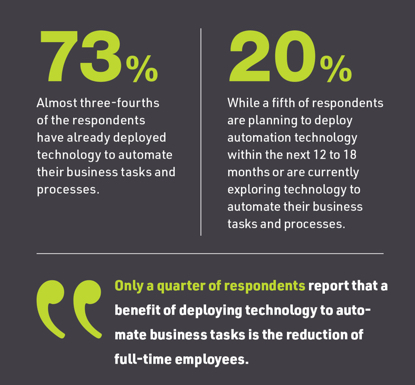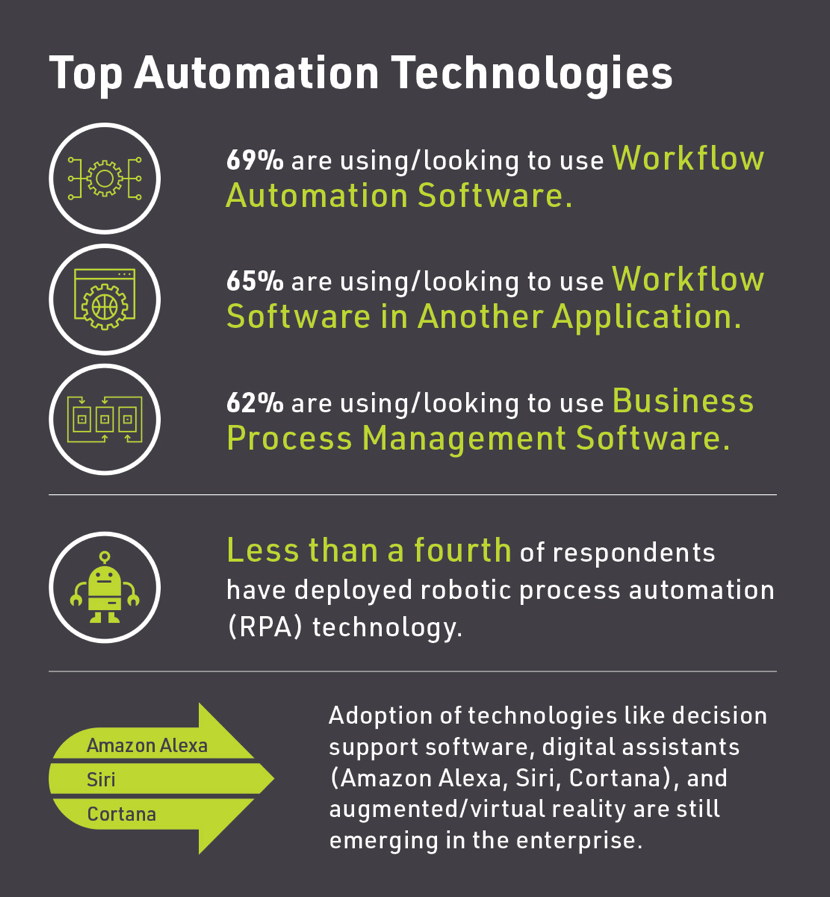This article appears in the Winter 2019 digital issue of DOCUMENT Strategy. Subscribe.

To better understand the opportunities and challenges facing organizations in their digital transformation efforts, IDC recently conducted a survey—in partnership with DOCUMENT Strategy—to see how businesses are using technology to improve their operational efficiencies, reduce costs, drive new revenue, and build deeper relationships with employees, partners, and customers.
 Two-thirds of survey respondents were based in the US, while over a third reside outside the country. Top industries represented in the survey include insurance, education, professional services, government, and healthcare. A little over 40% of the respondents work inside a large enterprise (over 5,000 employees worldwide). For the purpose of this survey, we define automation as a means to minimize or eliminate manual touch by deploying technology for a specific business benefit. This automation may augment or replace human activities. The vast majority of respondents (roughly 81%) report they have already deployed software to automate business tasks and processes or expect to deploy this technology in the next 12 to 18 months.
Two-thirds of survey respondents were based in the US, while over a third reside outside the country. Top industries represented in the survey include insurance, education, professional services, government, and healthcare. A little over 40% of the respondents work inside a large enterprise (over 5,000 employees worldwide). For the purpose of this survey, we define automation as a means to minimize or eliminate manual touch by deploying technology for a specific business benefit. This automation may augment or replace human activities. The vast majority of respondents (roughly 81%) report they have already deployed software to automate business tasks and processes or expect to deploy this technology in the next 12 to 18 months.
Of those who have already deployed automation software (or about to deploy this technology), they are primarily using business process management (62%), workflow automation (69%), or workflow software that is embedded in another application, such as enterprise content management, content collaboration, capture, e-signature, etc., (65%). It’s of note that less than a quarter of this group have deployed robotic process management (RPA) technology. This segment still remains nascent, as organizations evaluate how RPA fits into the larger task automation ecosystem. Nonetheless, IDC expects RPA to be the fastest growing segment of automation technology, especially as it becomes more “intelligent” with the injection of artificial intelligence technology.

When it comes to the topic of automation, a common refrain we hear is “augmenting labor, not replacing it.” Survey respondents seem to agree, listing improved accuracy and/or error reduction (67%) and employee productivity (64%) as the top two benefits of deploying automation software. Perhaps most interesting, only a quarter report that reducing the number of full-time employees as a benefit. This aligns with the school of thought that offloading repetitive, mundane tasks leads to increased worker productivity and job satisfaction.


Image by: AndreyPopov, ©2019 Getty Images
By now, most organizations understand that embarking on a digital transformation journey is tantamount to their ability to compete in a changing and dynamic marketplace. At IDC, we expect the worldwide spending on the technologies and services that enable the digital transformation of business practices, products, and organizations to reach $1.97 trillion in 2022, with a compound annual growth rate of 16.7%. The rise of innovation accelerators, such as the Internet of things (IoT), robotics, and artificial intelligence, has only put more weight behind this mandate.
To better understand the opportunities and challenges facing organizations in their digital transformation efforts, IDC recently conducted a survey—in partnership with DOCUMENT Strategy—to see how businesses are using technology to improve their operational efficiencies, reduce costs, drive new revenue, and build deeper relationships with employees, partners, and customers.

A majority of respondents have already invested
in their digital transformation journey.
in their digital transformation journey.
Source: IDC & DOCUMENT Strategy, December 2018
Of those who have already deployed automation software (or about to deploy this technology), they are primarily using business process management (62%), workflow automation (69%), or workflow software that is embedded in another application, such as enterprise content management, content collaboration, capture, e-signature, etc., (65%). It’s of note that less than a quarter of this group have deployed robotic process management (RPA) technology. This segment still remains nascent, as organizations evaluate how RPA fits into the larger task automation ecosystem. Nonetheless, IDC expects RPA to be the fastest growing segment of automation technology, especially as it becomes more “intelligent” with the injection of artificial intelligence technology.

Only 24% of respondents report they have deployed RPA, while only 14% have deployed decision support software. Nine percent of respondents have deployed digital assistants or augmented/virtual reality, respectively.
Source: IDC & DOCUMENT Strategy, December 2018
When it comes to the topic of automation, a common refrain we hear is “augmenting labor, not replacing it.” Survey respondents seem to agree, listing improved accuracy and/or error reduction (67%) and employee productivity (64%) as the top two benefits of deploying automation software. Perhaps most interesting, only a quarter report that reducing the number of full-time employees as a benefit. This aligns with the school of thought that offloading repetitive, mundane tasks leads to increased worker productivity and job satisfaction.

The top benefits of deploying technology to automate business tasks are increased accuracy, employee productivity, and cost savings.
Source: IDC & DOCUMENT Strategy, December 2018
For more information on "The Automation Survey" and approaches for digital transformation, visit www.idc.com.
Holly Muscolino is the Research Vice President of the Content Technologies and Document Workflow group at IDC and is responsible for research related to enterprise content management, including records management and case management. Follow Holly on Twitter @hmuscolino.





![IDC graphics for Document Strategy[2]](https://cms-static.wehaacdn.com/documentmedia-com/images/IDC-graphics-for-Document-Strategy-2-.2474.widea.0.jpg)
